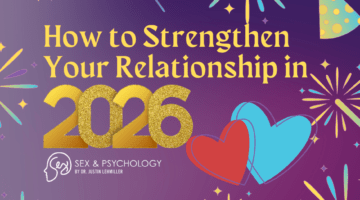Can “Friends With Benefits” Transition Into A Successful Romantic Relationship?
November 5, 2012 by Justin Lehmiller
Many people involved in “friends with benefits” (FWB) relationships are hoping that their relationship will eventually turn into a full-fledged romance. For instance, in a recent Internet survey of FWBs, 43.3% of women and 23.7% of men expressed a desire to eventually transition from “no strings attached” to true love (read more about that study here) [1]. Such findings beg the question of how often these relationships make the jump into romantic territory and, more importantly, whether they achieve success. A new study published in the Journal of Social and Personal Relationships provides some preliminary answers [2].
In this study, 764 college students who were currently involved in an exclusive dating relationship completed a survey about their current relationship experiences. Four months later, researchers followed up with each participant in order to determine whether they were still involved in the same relationship. Results from the first survey indicated that 150 participants (19.6% of the sample) said that they were “friends with benefits” before they became exclusive. In this study, FWB was defined as having “physical encounters” without an ongoing commitment. This tells us that FWBs do indeed turn into romances with some frequency, at least among college students.
In terms of relationship quality, all participants reported being relatively satisfied with their relationship on average, but those who were FWBs first reported being significantly less satisfied than those who did not have a prior sexual relationship. At the same time, however, prior FWB status was not associated with communication quality or “commitment ambiguity” (i.e., the degree to which the relationship was clearly defined). Prior FWB status was also unrelated to breakup. That is, across the four months of the study, participants who had prior FWB experience were no more likely to end their relationships than the other participants.
Of course, there are some inherent limitations of this research. For one thing, this study only sampled college students (with an average age of 19) involved in monogamous relationships. Thus, the frequency and success of relationship transitions in other populations (e.g., among older adults or in nonmonogamous romances) is unknown. The results also speak primarily to women’s experience, given that only 24 out of the 150 participants with prior FWB experience were men. As a result, it remains to be seen whether FWB history is related to different outcomes in men and women. Moreover, relationships were tracked for only a four month period, which means we have no sense of the long-term implications.
Nonetheless, these provocative findings tell us that, consistent with the desires of many FWB partners, it does indeed appear possible to transition from casual sex into a successful romantic relationship.
Want to learn more about The Psychology of Human Sexuality? Click here for a complete list of articles or like the Facebook page to get articles delivered to your newsfeed.
[1] Lehmiller, J. J., VanderDrift, L. E., & Kelly J. R. (2011). Sex differences in approaching friends with benefits relationships. The Journal of Sex Research, 48, 275-284.
[2] Owen, J., & Fincham, F. D. (2012). Friends with benefits relationships as a start to exclusive romantic relationships. Journal of Social and Personal Relationships, 29, 982-996.
Image Source: 123rf.com
Related Articles:

Dr. Justin Lehmiller
Founder & Owner of Sex and PsychologyDr. Justin Lehmiller is a social psychologist and Research Fellow at The Kinsey Institute. He runs the Sex and Psychology blog and podcast and is author of the popular book Tell Me What You Want. Dr. Lehmiller is an award-winning educator, and a prolific researcher who has published more than 50 academic works.
Read full bio >


